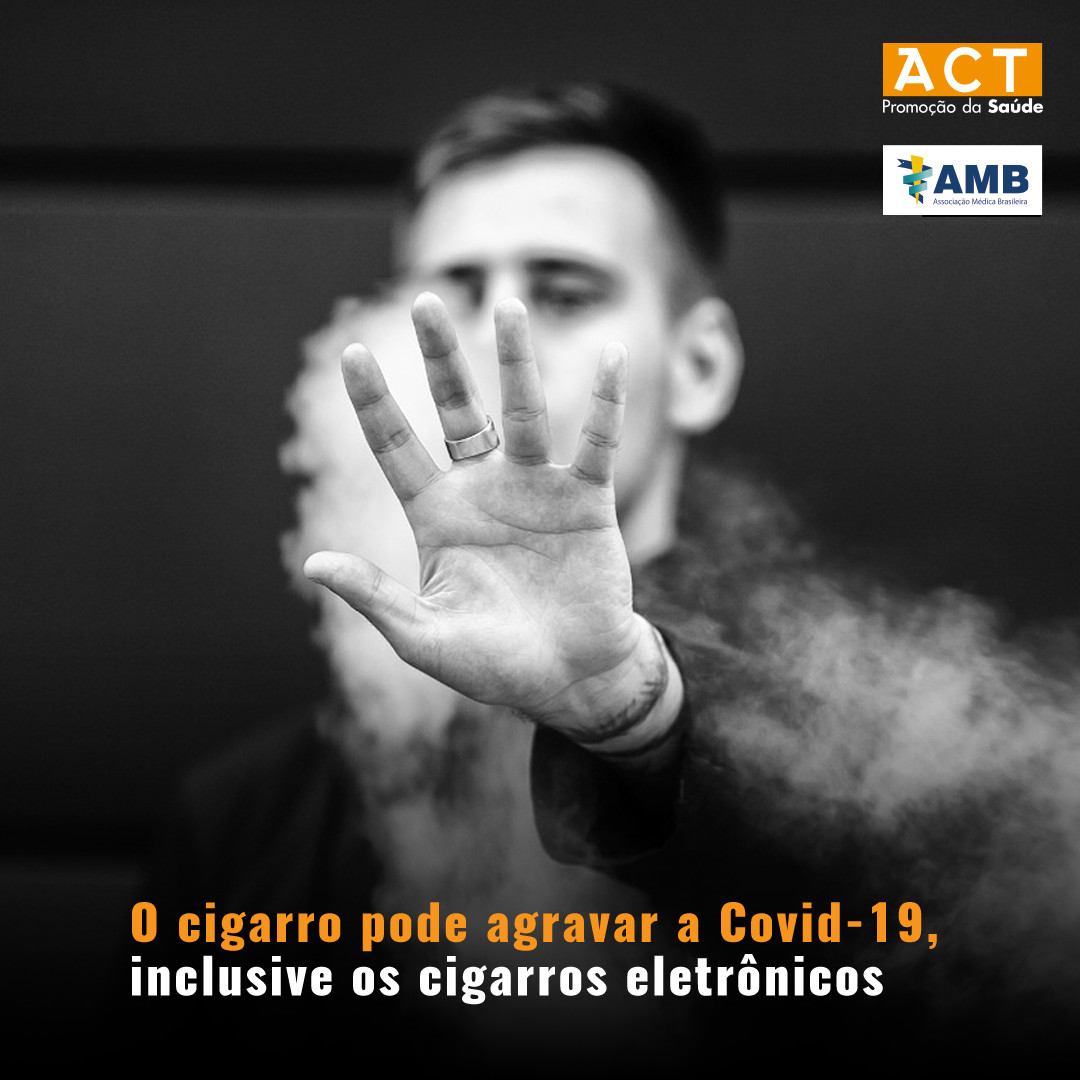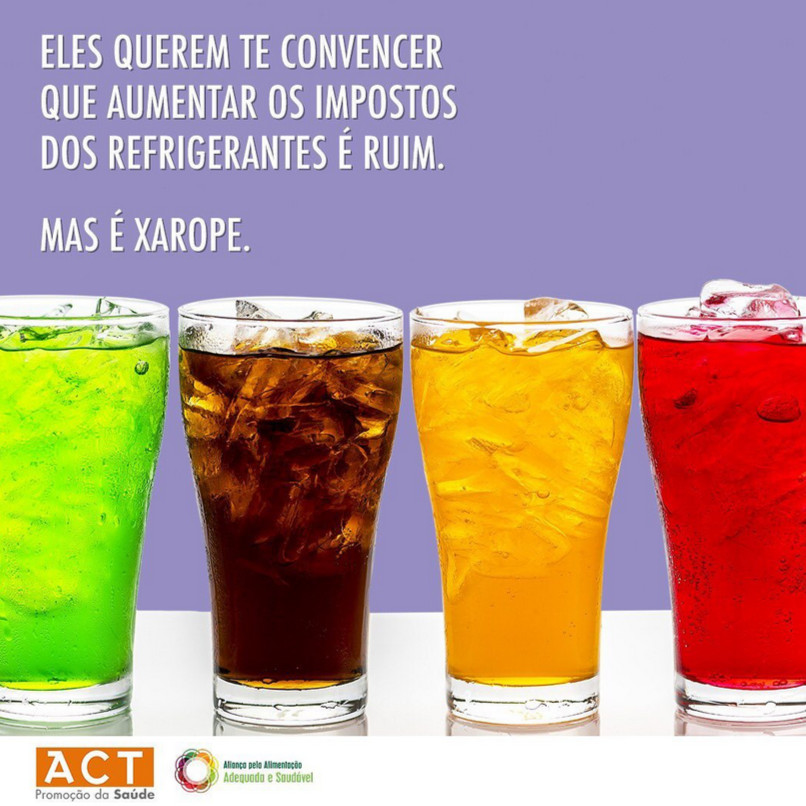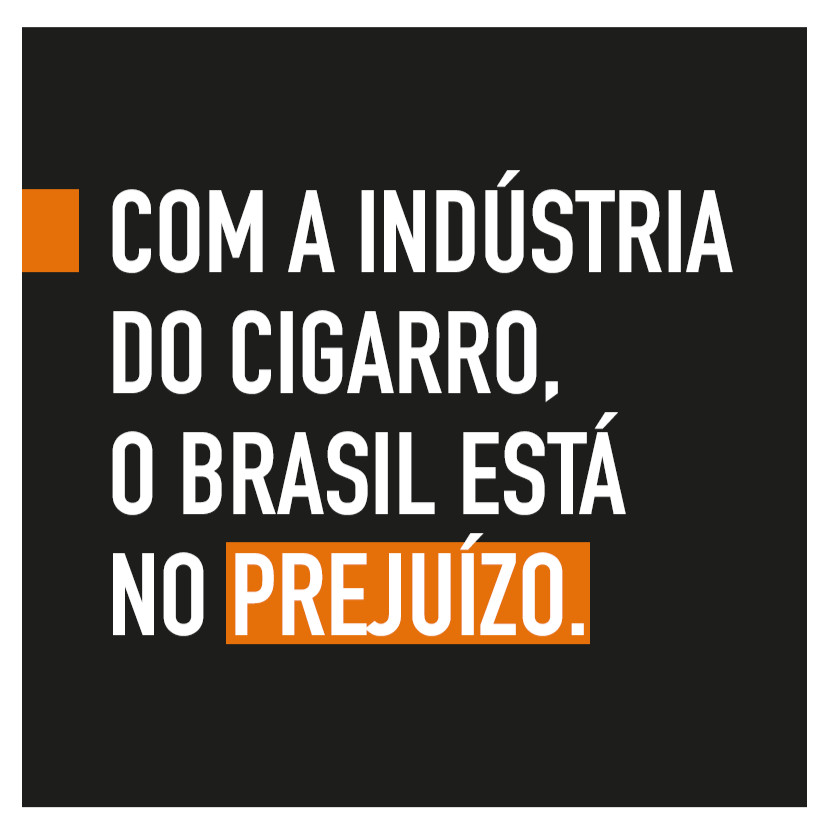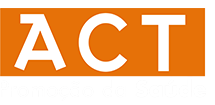Monitoring Bulletin - December 2020
14.12.20ACT Health Promotion
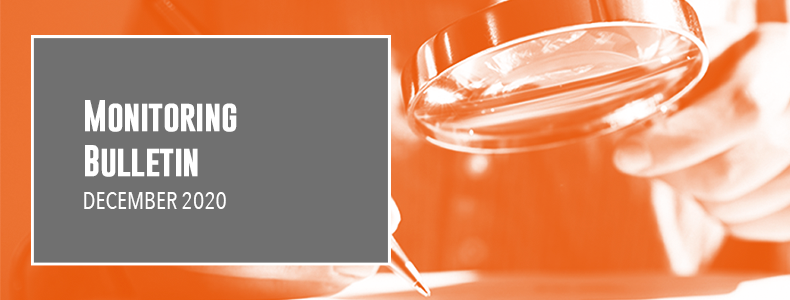
Editorial
Christmas is one of the most awaited dates of the year, because it is considered a time of union, peace, love, solidarity and renewal of hope. For companies, it is necessary to touch emotions, humanize the relationship with consumers and strengthen social responsibility and philanthropic values in order to reach out to hearts and minds and increase sales. Of everything. One of the most striking examples of the use of these elements can be seen in the Coca Cola end of year campaigns, as traditional as turkey and “rabanada” (French toast), which we will be talking about in the article “And So It is Christmas.
It is necessary to cast a critical eye beyond the beauty of the images and the technical capability of their advertising films, and not fail to realize that these companies are selling products which cause severe negative externalities, and that the bill is too steep for society as a whole.
Two conflict of interest and public health indexes can serve as good guides when this critical view becomes blurred in the face of marketing actions. One of them, developed by Global Health Advocacy Incubator, shows how major companies from the food and beverage industry directly and indirectly blocked out healthy diet policies and have exposed consumers who are already vulnerable to an even greater risk situation during the Covid-19 epidemic. The other, developed by the Stop Initiative, analyzes projects carried out by tobacco companies in 57 countries. Brazil’s position has risen in the ranks, which flashes a red light and explains the need for constant surveillance.
The article “Conflicts of interest in events and research involving harmful product industries” exposes sponsorship for seminars and studies in the health area and the search by manufacturers of harmful products such as ultra-processed foods and tobacco, for partnerships with professionals, universities and research groups, seeking legitimacy and credibility.
To attempt to transform products that are harmful to health and the environment, that contribute towards a burden of diseases and cause an impact on the public system into desirable, sustainable, ecologically correct and healthy brands is quite a challenge, but this is already happening within the marketing department at these companies. In “Building healthier brands and products” (Construindo marcas e produtos mais saudáveis), the authors show that in the face of a major diversion, such as the coronavirus pandemic can be regarded, some companies have taken the opportunity to rebuild their image more positively and test customer loyalty to their products, using emotions in the advertisements for their products. In many cases, they also employ a large dose of misinformation. What really matters at the end of the day is to increase market share, thus securing business and profits for their shareholders.
In this edition, we have invited Ricardo Brandão de Oliveira, a physical exercise specialist and urban mobility expert to approach a risk factor as dangerous as any other, but which is barely touched on in most cases. We are talking about inactivity, and its main vector, the auto industry and its sector associations, and the extreme ability to exert pressure on public policies which can reduce dependency on cars and stimulate more active forms of transport.
On behalf of the ACT team, I wish you a happy Holiday Season, and may 2021 be a year filled with real innovation and hope.
Anna Monteiro
Director of Communication
ACT Promoção da Saúde
E And So it is Christmas
Laura Cury and Victória Rabetim
New forms of social interaction have emerged with the Covid-19 pandemic, which includes Christmas celebrations. With the second wave emphatically upon us, with no end to the first one, and despite the optimism in regard to the vaccines, it is predicted that there will be fewer people round the table and many reduced dinner meetings, which could represent an interesting opportunity for the food and beverage industries.
The traditional Coca Cola caravan, the parade of trucks decorated with lights and Christmas figures rolling through the streets will be taking place with changes, since in order to avoid crowds the caravan schedules and dates will not be disclosed beforehand, as was the case in previous years. The intention is for the public to watch the show through the windows of their houses and apartments. The vehicles will be lighted up as per the usual custom, but there will be no participation by Santa Claus and other characters. In other countries such as the UK, for example, there will not even be a caravan, due to lockdown measures.
The major feature, however, will be the company’s new global Christmas campaign, titled “The Letter”, directed by Taika Waititi, nominated for the Oscar in 2020 for Best Movie and winner of the Best Screenplay award with feature length film Jojo Rabbit. The video celebrates the beverage’s 100th Christmas anniversary, to be broadcast in over 90 countries, Brazil being one of them. The story depicts a father’s love for his daughter and his adventures in order to fulfill her wish. It is worth remembering that Santa Claus has been associated to Coca Cola since 1920, when he was already illustrating campaigns for the brand. His current figure, of a chubby good-natured old man in red clothes, originates from a 1931 illustration by artist Haddon Sundblom. Since then, it has been impossible to imagine Santa Claus in any other shape or form. And to dissociate the brand from such an endearing figure. Who has even recommended cigarettes, but that’s another story.
The plot for the new Coke campaign, The Letter, is as follows: the little girl hands her father a letter to Santa Claus, but he forgets to post it and ends up embarking on a real saga, overcoming many obstacles, to get to the North Pole. On arriving there, however, he finds that Santa Claus is not home, but driving the traditional Coca-Cola truck. Santa agrees to give the man a ride home, fulfilling the wish expressed in the girl’s letter: to spend Christmas with her daddy.

With the message “this Christmas, the best gift is to be together”, the campaign suggests that the true magic at this time of year is the ability to connect people. Coke had already utilized a billboard ad in March this year in Times Square, with larger spacing between the letters of the logo and printed “Staying apart is the best way to stay united” and that the best gift we can give each other is our union.
According to Marina Rocha, Coca-Cola Brazil marketing director, “in this year which has been so difficult for all of us, let us convey a message of hope and remind everyone of the real value of Christmas: our new campaign has come to remind every one of us of the value of being present, of being close to those we love, even when we are far away. A beautiful touching story, which brings the iconic beloved image of Santa Claus and our red truck.” Furthermore, to Walter Susini, senior marketing vice-president of Coca-Cola Europe, “to spend the time with dedication and to be present at the moment with our loved ones will be the main priority above all”.
Of course, difficult times do tend to demand union. Some companies, however, also see marketing opportunities in the crisis, which can be addressed through the use of social responsibility and philanthropic values, as we highlighted in the June Monitoring Bulletin.
Christmas is one of the most awaited dates of the year, precisely because it is commonly understood as a moment of happiness, peace, love, solidarity and renovation of hope. After a difficult and atypical year such as 2020, with the addition of high contamination rates, travel restrictions and difficulties to have family and friends physically gathered together, this advertisement will certainly be a feast – or should we say an “unlimited round of drinks”? – to many people.
Conflict of interest in events and research involving harmful product industries
Bruna Kulik Hassan, Mariana Pinho, Camila Maranha
Researchers from Latin America, involved in the issue of conflicts of interests and interference by companies in public health, carried out an assessment which concluded that 88% of nutrition- and dietetics-related events held in the region between January 2018 and December 2019 received some sort of support or sponsorship. Data was gathered on food industry involvement through event and meeting sponsorships, talks by representatives from the food industry, scholarships, subsidies, prizes and other types of award, and concession of exhibition spaces and stands.
A recent case that drew attention in the field of Nutrition in 2020 was the Ibero-American Nutrition Foundation FINUT Conference, a virtual conference held in October. As is usually the case at in-person events, there was an online space reserved for the group of exhibitors, with special focus for Danone Mexico, the International Sweeteners Association, Herbalife Nutrition, medical publishers Editorial Médica Panamericana, the Institute of Nutrition for Central America and Panama (INCAP), Glaxo Smith Kline Laboratories (GSK) and Dutch health and food multinational Dutch States Mines (DSM). It was possible, through surveys, to gain access to research and disclosures by the exhibitors in digital format leaflets. Danone, for example, had seven thematic leaflets available for download. In particular, the pamphlet on child obesity included menus with snack options which included, together with processed foods, brand products such as Bonafont water or fruit drink and an assortment of Danonino yoghurt-type desserts (figure 1).
Figure 1. Part of the Danone leaflet on child obesity
The FINUT organization advised conference speakers and participants to disclose any funding received in their presentations, showing concern about the topic. But even with affirmative statements regarding conflicts of interest, tables formed by researchers who were funded on issues relevant to sponsors took place. And, as Marion Nestle showed in her book Unsavory Truth (Elefante Publishers), although researchers sign such statements, in practise things move in the opposite direction.
On the first day of the meeting, attention was drawn to the the session named Meeting with the experts: Low/no calorie sweeteners in public health: why is there controversy about their role in obesity and diabetes?, which showed no apparent association to any company in the business according to the event schedule. The session was chaired by Brian Cavagnari, with a Master’s degree in Food Technology and Nutrition on non-calorie sweetener metabolism and Hugo Laviada-Molina, university professor, director of the Center of Nutrition and Evidence-Based Medicine and coordinator of position papers on low/no calorie sweeteners. Both men share the fact that they are medical doctors and declared a conflict of interest for being funded by pharmaceutical and food and beverage companies, including one exhibitor at the conference, the International Sweetener Association. In addition, both focused on the problems of how studies are designed. The former addressed the effects of sweeteners on weight gain or loss, the latter, sweetener consumption and the risk of type 2 diabetes mellitus. Another factor in common is the defense of similar theses, stating that the problem related to the confusion with regard to inconclusive evidence about these relationships is the result of mixed evaluations of scientific evidence. They contended that results diverge between studies with randomized clinical trial designs, of higher quality of evidence, and cohort studies, which deliver a greater volume of evidence on the theme. In their presentations, however, they seem not to have taken into account problems of major variability among the surveys available and the lack of conclusive findings, even among the clinical trials.
Another session worthy of note was Breakfast in Latin America – data from Elans study – Comparison to international data and recommendations, a Latin American Study in Nutrition, carried out among countries in the region, gathering data on food consumption, physical exercise and association to anthropometric profile. Mauro Fisberg, associate professor at the São Paulo School of Medicine, Federal University of São Paulo State (Escola Paulista de Medicina da Universidade Federal de São Paulo) and Coordinator of the Center for Nutrition and Dietary Difficulties at the Instituto Pensi-Sabará Children’s Hospital, presented a historical record and the importance of breakfast for Latin America. His conflict of interest list was one of the longest, with some of his sponsors clearly interested in addressing the importance of this daily meal, such as Danone, Nestlé and General Mills. Despite presenting different scenarios regarding the consumption of breakfast and its importance to health and nutrition, no mention was made of the “Dietary Guidelines for the Brazilian Population” (Guia Alimentar para a População Brasileira), which not only recommends consumption of the meal, but also provides examples of in natura or minimally processed foods.
Presenting The International Breakfast Research Initiatives (IBRI) projects and breakfast around the world, Michael Gibney, researcher and professor from University College Dublin, revealed he had rendered consultancy services to Cereal Partners Worldwide (CPW). According to information on the Nestlé website, CPW, based in Switzerland, was founded in 1990 jointly with General Mills, and “is a leading worldwide breakfast cereal company behind some of the world’s most iconic breakfast cereal brands”. IBRI on the other hand gathers national dietary research data from Canada, Denmark, France, Spain, United Kingdom and USA, seeking to explore approaches towards defining the ideal intake of foods and nutrients at breakfast.
The article published by Gibney in Nutrients magazine, jointly developed with co-authors from CPW, Nestlé, among others, indicates that the “data will be valuable to food guide and public health policy-makers, as well as to food manufacturers, and will also allow consistent messages helping consumers to optimize food choices at breakfast.” On the Nutrition Nestlé Institute website it is possible to find reference to the IBRI and a presentation given by Gibney. It is worth remembering that this researcher has already been described as “the person spearheading” the attacks against the NOVA Classification contained in the Dietary Guidelines for the Brazilian Population. But going back to the presentation, Gibney made clear the need for more fiber at breakfast tables worldwide, leaving a far from rhetorical doubt in the air about where to obtain it.
Following the presentation, financed by General Mills and CPW, Jaqueline Lopes Pereira, post-doctoral fellow from the University of São Paulo (USP) School of Public Health proceeded to present the Elans Study followed by Elans researcher, medical doctor and professor Irina Kovalskys, also Coordinator of the ILSI Argentina Committee for Nutrition, Health and Quality of Life, a collaborator of IBRI and member of the Argentine Nutrition Society. The ILSI, International Life Sciences Institute, is a research organization which brings together the largest multinational ultra-processed food manufacturers.
Elans analyses showed how breakfast contributes to a better daily intake of various nutrients. In conclusion, they highlighted the need for a standardized nutritional recommendation reference for breakfast in Latin America.
The presentations for the session delivered a unison of final recommendations: although there is already a reasonable level of consumption of breakfast foods, specific and quantitative nutritional recommendations are necessary for this meal. Let us not forget here the divergence of this observation with regard to the Dietary Guidelines for the Brazilian Population, which delivers qualitative recommendations and whose golden rule is to avoid ultra-processed food products, such as the ultra-processed breakfast cereals sold by the aforementioned companies.
In parallel to the food sector case, we continued to identify more and more examples in the tobacco sector. A report resulting from a journalistic investigation clearly showed how tobacco companies have been harassing doctors and health professionals over time. The first pieces of advertising material with health authorities date back to the 1940’s. It would be wrong to assume that this relationship is “a thing of the past”. The reporters identified a string of events supported and sponsored by tobacco companies in 2017 as well as funding research to be presented at medical conferences in Brazil. Advertising of tobacco- or non-tobacco smoke-related products, and that includes everything you can think of related to smoking, is forbidden, but scientific discussion is not.
Scientific investigation is necessary. The academic sector must research and analyze findings, especially in current times, relating to new products that are being shoved down the lungs of consumers in the markets where they are allowed, and unlawfully in the ones that have not yet authorized their sale. This university-company relationship must be free from the comercial interests of the industry which kills two out of three of their consumers, even under the allegation that there is now a novelty which would “kill a bit less”. It is not just a case of turning a blind eye to the harm they cause to society.
It was reported that São Paulo and Mackenzie Universities held a workshop to plan a Police Force Cooperation Course in the Triple Border area, to combat cigarette smuggling, with the support of Philip Morris International within the scope of the "PMI-Impact" stimulus program. This project involves the Ministry of Justice, since repressive action against smuggling is carried out by agents of the Federal Highway Patrol and Customs Office.
Additionally, São Leopoldo Mandic College held the II International Tobacco Damage Reduction Seminar in November, with support by Phillip Morris. The event was also organized by VaporAqui, owned by Alexandro Lucian, a user and promotor of vaping and related accessories. Researchers and health professionals, especially from the field of drug addiction/chemical dependency, discussed electronic smoking devices. It is worth mentioning that the education institute and the tobacco company had already approached each other, which suggests a strategic partnership.
To provide an opening for the tobacco industry to issue opinions on tobacco control policies goes totally against the obligation taken on by the federal government in 2005 when they ratified the Framework Convention for Tobacco Control and made a commitment to protect the public health policy against the comercial interests of the tobacco companies. The industry notably diversifies the products and targets of its institutional promotion strategies. It does not establish key partnerships merely to promote its portfolio, but as an important point to build a positive image of the company, thus moving away from any type of association of its product to health hazards.
The good news is that these practices have been increasingly discussed at a worldwide level, and it is no surprise that recognition of this problem as such starts off precisely by the tobacco industry. The recently launched Global Tobacco Industry Interference Index, for example, lists the participation of government representatives in events sponsored by the industries as one of such forms of unnecessary interaction. Hopefully this can serve as an example for other areas and indeed, for the case of tobacco.
Bulding healthier brands and products
Laura Cury, Bruna Kulik Hassan, Mariana Pinho
The Covid-19 pandemic led some industries to rethink their sales and marketing strategies, with some of them possibly not seeing a return to former consumption levels. When restrictions are reduced, one option is to rebuild more strongly and more quickly and use marketing techniques to attract people into consuming more, basically a turbocharged new normal to make up for losses incurred in 2020.
Another strategy is to help brands become more resilient and resistant to external shocks such as the pandemic, as well as to climate changes and environmental devastation, for example. For these companies, instead of rebuilding more strongly and more quickly, marketing is viewed as the possibility for a better form of reconstruction. The idea is that a better version of the usual business will always end up creating commercial resilience, as well as building customer loyalty over time.
Since its appearance in 2010, Building Healthier Brands has had the mission of “taking the food and beverage sector out of the comfort zone”. The event gathers professionals from departments such as marketing, research and development, and lists among its funders companies such as WellFood Ingredients, Seara Nature and Heineken, among others. As one of the main trending and innovation events in the sector, it comprises the main themes on marketing, health and nutrition. The trend, however, takes on a new meaning with more leverage in a pandemic world.
Research shows that people who live with chronic non-communicable disease are at a greater risk of receiving a more serious diagnosis, of aggravating their clinical profile or dying from Covid-19. Consumption of tobacco and alcoholic products and ultra-processed foods, therefore, now represents an even greater threat to consumers’ health, who are being compelled to reexamine their health as well as their consumer habits. The pandemic increased the consumption of the first two product categories mentioned, but an improvement in eating habits has been noted among the Brazilian population during the period, through higher consumption of healthier foods, although some tendencies towards ultra-processed foods can be observed.
As a consequence, manufacturers of these products have sought to attract consumers displaying an array of reformulated and supposedly healthier products. Even prior to the pandemic, the healthy foods sector was growing and was worth over US$ 1 trillion worldwide, but this trend was sharpened with the pandemic. According to Peter Wennström, founder of the Healthy Marketing Team, the post-Covid 19 future is all about prevention and health through diet”. On the other hand, according to Rick Miller, associate director of specialized nutrition at Mintel, a market intelligence agency, “the trend for immunity is not transitory. It will get stronger and continue to grow, at least until we get a vaccine. The absence of a vaccine encourages experimentation. Consumers will look elsewhere. People will devise their own faith and belief system. Food and beverages that can support the immune system are of great interest to consumers (...).”
Figure 1- Immunity Booster Bread / Source: https://www.foodhospitality.in/latest-updates/bonn-launches-herb-seeds-bread-to-boost-immunity-during-covid-19-pandemic/421201/
Surveys on the anti-inflammatory benefits of fruits and vegetables have provided a boost for vegetable-based diets during the pandemic; nature has taken on a new meaning, but that is not to say that consumption of all vegetable-based products has been on the rise. “We all know that people want more plants, but they want plants they can understand. (...) one thing that is being highly praised is plant-based meat substitutes made from soy protein or peas. We were told that people would go crazy about it with the Covid-19 pandemic, but that hasn’t happened”, says Julian Mellentin, founder of New Nutrition Business. Mellentin points out that plant-based alternatives were left on the shelf by consumers in some cases during the panic-buying phase. In any case, advertising for these products has been growing over the last few months.
Figura 2 – “Incrível” (Incredible) line by Seara / Source: https://www.incrivelseara.com.br/
Indeed, one product class which has indeed been plastered on advertisement pages and shelves is that of vitamin supplements. This is because way back in March and Abril, still in the early days of the pandemic, a large amount of (dis)information appeared about substances presented as supposed protectors against Covid-19. Vitamin D and a few other commodities were pointed out as part of the solution, although there is no research that is free from conflicts of interests to prove that they would be important both for preventing and curing Covid-19.
Self-image reinvention seems to be the focus of BRF Foods, the world’s largest poultry exporter and second biggest producer of animal protein, who launched a campaign touching on the subject of caring for their staff and the population and practicing environment protection. Despite receiving fewer headlines than other issues related to the Covid-19 theme, outparbreaks of the disease in refrigerated warehouses occur in many parts of Brazil. In Dourados, in the state of Mato Grosso do Sul, 1,075 cases of Covid-19 out of a total of three thousand corresponded to JBS employees.
Because of the health crisis, BRF was impacted in terms of production, with the rise in the US Dollar and grain prices. Net profit fell 50% compared to the same period in 2019. Even so, the company performed above expectations in the third quarter of 2020, with 17.5% net revenue growth and profits of R$ 219 million for the period, exceeding expectations. The main reasons were the increase in the price of their products and steady exports.
In the #NossaPartePeloTodo (OneForAll) campaign, BRF declared their commitment to an ethical and sustainable world, but went nowhere near exposing that some of their products admittedly carry a risk of obesity and other CNCD’s, the main diseases related to the aggravation of Covid-19.
The reinvention of harmful products is an attempt by the industries, and the case of tobacco is a perfect example, with its new electronic smoking devices, such as e-cigarettes and heated tobacco. In order to try to reduce harm to smokers, including passive smokers, electronic cigarettes were invented, which brought along with them a vaporized puff of untruths periodically contested by science, publication after publication. The industry invests a lot in order to develop these new products, with great results.
The revenue for Phillip Morris International generated by these devices in 2019 was US$ 5.6 billion, representing an 18.7% increase compared to the year before. Its competitor, British American Tobacco, also recorded a growth in this new product category to £1.3 billion, a 37% increment in 2019, twice the revenue compared to two years previously.
Figures 3 and 4: Instagram screen prints / Source - Mariana Pinho
Considering the history of these companies and the fatal features of their main product, there is nothing considered more innovative than to become associated to products flaunting damage reduction. Every argumentation used for the promotion of electronic devices leads the consumer to imagine that they could be harmless: it’s only steam, after all, but there is a lot of technology behind them, associating them to a false idea of security.
Electronic smoking devices are just one more product in their portfolios. As much as the CEO of PMI, for example, has already stated time after time that they intend to stop selling the conventional products, the tobacco product market remains. Champions of public health draw attention to the fallacy of the discourse employed by manufacturers.
The case of tobacco perfectly illustrates the warning by specialists in public health and conflicts of interest the world over that one must be cautious before accepting that a redesigned product, supported by science and technology, is necessarily beneficial to the health of consumers.
And here, more than ever, the age old sentence, printed on every pack, says it all. Warning by the Health Ministry: smoking damages your health. So does vaping.
Auto industry: a new look towards a healthier and more sustainable future
Ricardo Brandão de Oliveira, P.E. Teacher, Active life Lab Coordinator and Assistant Coordinator at UERJ Sports and Exercise Post-Graduation Program
As it deconstructs paradigms, the Covid-19 pandemic sets before us issues regarding what future we want in our towns and cities. With the reduction in motor vehicle use and the increase in infrastructure aimed towards the use of active transport in many towns and cities around the world, it has been observed during the pandemic that there is a reduction in traffic jams and traffic accidents. Air quality has improved and many have begun to benefit from the effects on their health of more active modes of transport, such as bicycles and hiking.
Health benefits related to a greater use of active transport are widely described in scientific literature and exceed the risks associated to exposure to air pollution and traffic accidents in practically all the towns and cities assessed. Researchers from New Zealand concluded that if one out of every four car trips in their country, for distances of up to five kilometers, were taken using active transport, the effects on quality of life would be equivalent to one of the most important health policies: 10% tax on tobacco. Greater use of active transport systems in towns and cities has also been associated to important economic impacts on the Brazilian National Health System (SUS) and the environment, through cost reduction for chronic non-communicable diseases and reduction in carbon gas emissions.
Despite all the evidence and progress achieved in the political arena with the approval of the Urban Mobility National Policy (Plano Nacional de Mobilidade Urbana – Law 12.587/2012) and the Bicicleta Brasil Program (Law 13.724/2017), whose guidelines include the prioritization of non-motorized modes of transport over motorized modes and of collective public transport services over individual motor transport, what we see in practice is an increase in car fleets, stimulated by tax incentives, also in the periods when economic policy guidelines were in favor of greater restriction for industrial policies.
If on one hand evidence is growing which demonstrates the many positive effects of investments aimed at greater use of active transports, systematic reviews reveal huge impacts of cities centered on car use on public health.
In general , in this list can be included:
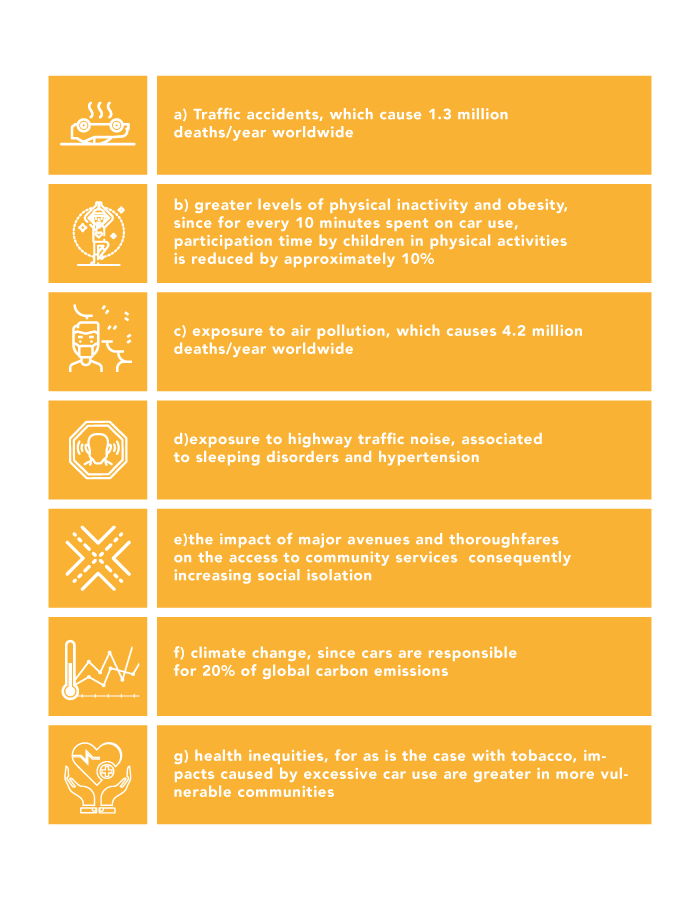
In the face of all the evidence exposed, some questions are inevitable: For what reason do we still have cities focused on car use? Why are investments aimed at increasing the use of active transport not prioritized as an important public health policy?
The benchmark on the Commercial Dimension of Social Health Determinants in the agenda to face chronic non-communicable diseases, launched in November 2020 by the Pan American Health Organization, discusses common practices carried out by major corporations; among the most relevant ones are the influence of the unhealthy product industry, such as tobacco, ultra-processed foods and alcoholic beverages, known as the Big Three, which are known to be related to the main CNCD risk factors, and consequently to a greater burden of these diseases.
Despite being recognized by researchers, scientific societies and health organizations all over the world as one of the most important risk factors for CNCDs, physical inactivity is not mentioned once in this benchmark. The document mentions, nevertheless, that according to the report by The Lancet Commission on the Global Syndemic, the balance of power among the players within the governance mechanisms can determine the enforcement of laws and regulations, economic incentives and disincentives, as well as norms and prospects of society, quoting the example of investments on roads being prioritized in detriment of public transport and active commuting.
If priority investment in roads is deemed a barrier to the use of more active modes of transport, it would be appropriate to include the auto sector on the list of unhealthy product industries.
Accountable for around 22% of Brazilian industrial GDP, with a turnover of US$ 59 billion in 2015, the production growth in the auto sector is still considered an important economic booster for the country, without its externalities being counterbalanced by policies favorable to society.
When we compare lobbying action by the auto industry with actions carried out by the Big Three, we note many similarities striding towards preventing public policies which affect their economic interests to advance. As with the alcoholic beverage industry, hefty investments in marketing are designed to create the perception that their products represent aspiration and social status, establishing a cultural norm associated to purchasing and using cars. Automobile advertising can have psychosocial effects on health, both directly, through encouragement to purchase bigger and more dangerous cars, and indirectly, through validation of "aggressive male" behavior when driving. Additionally, omnipresent advertising helps to normalize physical inactivity.



Driving has become such a normal part of everyday life that many car owners no longer question the use of cars for short trips. In São Paulo, for example, it is estimated that 25% of daily car journey routes are under three kilometers and that 60% are not longer than five kilometers. On the other hand, hiking is no longer a natural activity and has become a type of physical exercise/activity that health agencies are struggling to promote.
All these industries count on professionals and associated companies who allegedly defend regulation discourses as a form of establishing presence in groups of influence and political decision makers who in the end act to obstruct the implementation of laws that go against their economic interests.
During the 1980s, automobile companies became founding members of the Global Climate Coalition, a group of powerful companies in the United States who opposed environmental regulations and achieved the objective of withdrawing the U.S. from the Kyoto Protocol, an instrument in the UN Framework Convention on Climate Change. In 2006, the UK Royal Society, the world’s oldest science academy, wrote to oil giant Exxon expressing concerns about the support that ExxonMobil had been providing to organizations that misinformed the public about scientific data regarding climate change, in the same way the tobacco industry does with regard to the risks related to electronic smoking devices. Although the oil and auto industries adopt advertising strategies geared towards supporting the environmental agenda, investment in renewable energies is still lower than expenditure on fossil fuel field research. The FIA Foundation for the Automobile and Society, despite adopting a discourse addressing road safety and accident reduction, continues to promote little more than educational measures focused on the pedestrian, which are admittedly inefficient, and supporting large scale investments in motorway construction in low-income countries.
In August 2020, the National Association of City Transportation Official, NACTO, a coalition of U.S. Municipal transport departments, in a partnership with the FIA Foundation and other organizations, held an event to launch the “Designing Streets for Kids” guide, in which the countless benefits of sustainable planned streets are discussed in a safe and friendly way to children. It is, at the very least, curious to see an organization which says it carries out surveys on public policy issues related to the interaction between automobiles and society, who supports initiatives to improve environmental performance in cars and that serves the interests of the auto sector and promotes actions aimed at safer streets, since part of the solutions involve lower levels of car use in towns and cities.
Cigarettes, alcoholic and sweet beverages and cars are normally positioned as individual rights and choices issues. Lobbies usually coin the Nanny State expression as a way to attack government programs which regulate, for example, cigarette use and reduce car speeds. The self-regulation argument has been a common practice by all these industries. They finance researchers and produce disinformation about the harmful effects of their products. In the end, they shift their markets to low- and middle-income countries, where local governments and organized civil society have limited power to fight against their actions.
Despite the similarities, car lobbies are usually much more diffuse, and can include automobile manufacturers, auto dealers, car rental companies, garages, auto associations and organizations, the oil industry, road construction companies, civil construction contractors and others, making it more difficult to monitor and define.
To promote education instead of regulation have been some of the strategies preferred by the alcohol, tobacco and road safety industries, despite being recognized as less effective than interventions destined to restrict publicity and tax policies.
To consider the negative effects of the auto industry has currently become imperative to public health. To include in the same agenda traffic accidents, obesity, physical inactivity, air pollution and climate change with the social processes which established car domination offers a new direction for social epidemiology.

